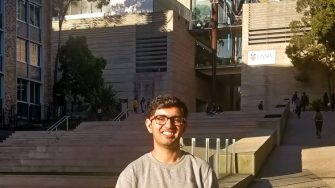International Practicum Visit
Practicum student Vishesh visited us for 2 months, here is what he has to say about his stay:
Practicum student Vishesh visited us for 2 months, here is what he has to say about his stay:

My name is Vishesh Kashyap and I am currently a final year undergraduate student of Mechanical Engineering at Delhi Technological University, Delhi, India. I visited the University of New South Wales, Sydney in June-July 2019 as a Research Practicum Student under the supervision of Dr Susann Beier.
My time at Sydney was also my first solo visit abroad, which made it all the more unique in nature. Before visiting, I had approached the UNSW Practicum Office for assistance regarding accommodation, and had been able to select a place to stay at a walking distance from the University. I lived at a homestay with a really helpful and perpetually available Australian family. My hosts loved cooking, and provided me with breakfast and dinner; what made it all the more special was that I got have Indian food twice a week!
Sydney is a beautiful city in all regards, and well-connected by public transport. I planned my weekends in order to be able to savour as much of it as possible; as it turned out, I had enough time to see sites in the city as well as far beyond its bounds. While markets and locales closing before sundown is something unheard of in my city, it did give me time to rest or make multiple visits to Circular Quay or Darling Harbour. Both Sydney’s architecture and the multiple natural sites in and around it are hard to get used to - they awe one equally every time
On my first day at UNSW, we had a short orientation at the International Office, where were acquainted with regulations and allotted our zIDs. Once I had had my ID card made and figured my way around campus, I was able to report to the School of Mechanical and Manufacturing Engineering, my place of work.
Conducting research at UNSW was a clear step above all the work I had done until then, particularly in terms of the computational infrastructure and resources I was provided access to within the first week of my joining. This, coupled with a mentor who was always there to help, aided me in hitting the ground running and beginning my project in full earnest within a couple of weeks.
The environment at UNSW, especially where I was set up, was very conducive to carrying out research with focus. I could come in early, work till late or even carry out my computational work remotely, and was hence able to stay ahead of schedule and meet my project objectives duly. For every problem I had along the way, solutions were readily available, and it was never long before work could be continued normally. New ideas pitched by me were given due consideration, discussed and implemented swiftly; this allowed for the addition of new aspects and greater details to the projects I was a part of.
My time at UNSW was a period of great learning for me, chiefly in the methodology and procedure of research. I was encouraged to work independently and provided with all the resources to do so. Our group had a meeting every Tuesday evening, in which members would appraise Dr. Beier with updates on their respective projects, clarify doubts and chart the way forward. This acquainted us with the procedures being followed by other members, and helped us come up with new ideas of our own. Another major learning was the importance of documenting results, and how helpful the correct method of doing so can be in assessing and analyzing one’s work. All these were combined with extremely interesting additions in scientific knowledge; working at the interface of mechanical engineering and medical science, there wasn’t a single day when I didn’t learn something new.
By the end of my stay, I was able to learn about topics and methods that will be integral to any research I may be a part of now. The projects I was able to contribute to helped add a new dimension to my knowledge, and I’m sure this has been an important stepping stone in my future academic aspirations.